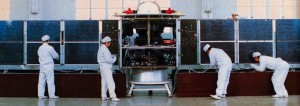
China's Fengyun-1C meteorological-monitoring spacecraft. Courtesy: NASA’s Orbital Debris Quarterly News
It was seven years ago this month that China purposely destroyed its own Fengyun-1C meteorological-monitoring spacecraft via a Chinese anti-satellite (ASAT) weapon.
That January 11, 2007 event represents the worst single debris contamination of low Earth orbit.
NASA’s just-issued Orbital Debris Quarterly News has spotlighted the event, noting that the ASAT test placed hundreds of operational spacecraft, including all human space flight missions, at continuing risk.
The newsletter observes: “To date, the U.S. Space Surveillance Network has cataloged nearly 3,400 distinct debris from the former meteorological satellite. These debris range in size from 5 cm to nearly a meter.”
Lingering leftovers
Furthermore, the rate of reentry of these debris has been very slow, due in part to the high altitude of Fengyun-1C at the time of its destruction, and in part to the recent lower-than-normal level of solar activity.
Because of the cosmic leftovers, numerous spacecraft have already been forced to execute evasive maneuvers to avoid potentially catastrophic collisions with debris from Fengyun-1C.
The International Space Station conducted such a maneuver in January 2012, as have NASA’s Terra, Aqua, and Cloudsat satellites and many other spacecraft, the newsletter reports.
By Leonard David
